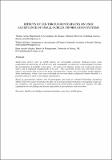Effects Of See-Through Interfaces On User Acceptance Of Small-Screen Information Systems
Date
2008-11-26Author
van der Heijden, Hans
Golden, William
Acton, Thomas
Metadata
Show full item recordUsage
This item's downloads: 442 (view details)
Recommended Citation
Acton, T., Golden, W. & Van der Heijden, H. (2005) Effects Of See-Through Interfaces On User Acceptance Of Small-Screen Information Systems, 13th European Conference on Information Systems, Regensburg, Germany, May 26-28.
Abstract
Small-screen devices such as mobile phones are increasingly pervasive. Reduced screen areas
compromise the ease-of-use of such devices, and consequently, a concern for system designers becomes
the maximization of available screen space. On large-screen displays, menus can overlap and obscure
others, and be displayed simultaneously to the user. This is generally not the case with small screens:
where a user selects from an on-screen menu, that menu must "vacate" the screen before another appears.
Menu translucency, where a user can see through an on-screen menu to displayed elements beneath, is a
possible solution to small-screen display maximization.
Based on experimental evidence with 70 participants, and using an extended Technology Acceptance
Model (TAM) this research examines the effect of on-screen translucent menus on perceptions of ease-of-
use, usefulness, and enjoyment for a third generation mobile phone prototype user interface. We offer
explanations for our findings and discuss implications for practitioners and researchers.


